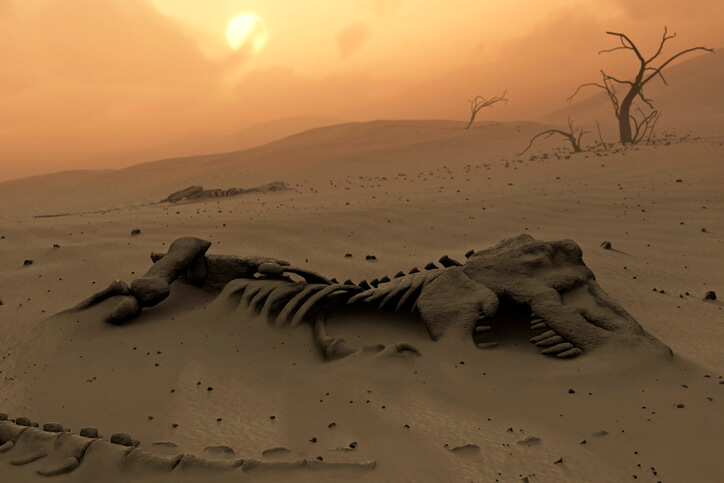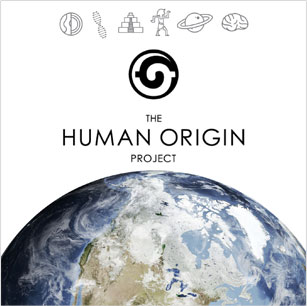Mass extinctions seem like something written into disaster movie scripts. The prehistoric disappearance of the dinosaurs is well-known, yet difficult to imagine without Steven Spielberg.
Throughout the prehistoric ages, mass extinctions have shaped life on earth. However, as humans, it’s difficult to imagine an event occurring in our lifetime.
What if our prehistoric ancestor’s lives were shaped by mass extinction?
A lesser known and much more recent species extinction could have impacted the rise of human civilization. Scientists are now revealing the details that occurred just as modern humans transitioned into the farming revolution.
In this article, we’ll explore the relationship between prehistoric ages, the Younger Dryas Event and the rise of human civilization.
What are the five major extinctions of prehistoric ages?
Mass extinctions are rapid disappearance events that occur over a very brief time in earth’s history. These include marine and terrestrial life and associated with cosmic impacts and huge environmental changes. These include extreme weather, volcanic activity and rapid climate change over long spans of time.
Of all the species of plant and animal to have ever lived, 99.9% are now extinct. The question remains, what happened to them? There have been several mass extinction events throughout prehistory that has seen life on earth dramatically reduced.
The Top Five Species Extinctions on Earth
- Ordovician-Silurian Extinction:
Small marine organisms died out. (440 million years ago) - Devonian Extinction:
Many tropical marine species went extinct. (365 million years ago) - Permian-Triassic Extinction:
The largest mass extinction event in Earth’s history affected a range of species, including many vertebrates. (250 mya) - Triassic-Jurassic Extinction:
The extinction of other vertebrate species on land allowed dinosaurs to flourish. (210 mya) - Cretaceous-tertiary Extinction: (65.5 mya)
The biggest extinction in earth’s history
Prehistoric ages were rocked by an extinction event that nearly put an end to all life on earth. The Permian Age extinction at 250 million years ago is believed to have wiped 95% of life from the planet.
Catastrophic conditions created a low oxygen atmosphere, high temperatures, extreme fires, and acid rain. At this stage, it is unknown exactly what caused these conditions.
Over a period of one million years, volcanic eruptions spewed out over 300 million square kilometers of lava. The earth was sent into intense global warming as C02 levels skyrocketed, this triggered frozen methane under the sea to melt.
Methane is 20 times more potent greenhouse gas than C02. Global warming was accelerated which inevitably led to 85% or more of marine life to become extinct, as well as 70% of land vertebras.
The prehistoric Permian Age extinction vastly shaped life on earth.
The dinosaur extinction event
65 million years saw the almost complete disappearance of the dinosaurs from the planet. During this period 50% of all plant and animal life on earth died off. This event marked the end of the Cretaceous Era and the start of the tertiary period.
For a long time, scientists did not know what had triggered the dinosaur extinction. Theories included volcanoes and plate tectonics; however, it wasn’t until 1980 that the meteor impact theory was first presented.
Evidence was first discovered in Northern Italy of a sediment layer indicating an impact dating to 65 million years. More data was found in New Zealand and Denmark of the rare and space associated element Iridium.
The platinum group metal is found on the earth at levels of 0.3 parts per billion. The iridium-rich layer had levels 9.0 parts per billion or higher.
This sparked debate as to the cosmic origins of the iridium-rich findings. The layer corresponded directly with the many dinosaur fossils already uncovered.
However, extinction science is a slow-moving process. The theory was not widely accepted, because the scientists at the time could not locate a crater to match their findings.
It took ten years of further research to uncover a crater in the Yucatan Peninsula, which dated to 65 million years. It was a direct match to the Iridium layer and all but confirmed the main cause for the dinosaurs’ extinction.
The Younger Dryas Event & agricultural revolution
12000 years ago, at the end of the last ice age saw the dawn of human civilization. It occurred as farming practices began in the fertile crescent during a 1200-year period known as the Younger Dryas. It’s also a geological time when dramatic changes happened across the earth.
The Younger Dryas was the time of the most recent mass extinctions when 75% of the world’s megafauna disappeared. The rapid melting of the North American ice sheet meant that global sea levels rose 400 feet.
Much less is known about the end of this prehistoric period than what is understood of the dinosaur mass extinction.
The mystery of the Younger Dryas period
At the cusp of the human farming revolution, a mass extinction has slowly revealed itself. However, the Younger Dryas period is still mostly a scientific mystery. Evidence has appeared that suggest both extinction and disaster like conditions during this period.
The abrupt nature of the megafaunal extinctions all at the same time suggests influence from conditions on earth.
The graph below outlines the Younger Dryas extinctions compared to the fossil record of the past 50 000 years.
Each square represents the finding of a fossil species. At the end of the last ice age, roughly 120 species of mammals became extinct during the Younger Dryas period. This spike is documented by fossil remains that coincided precisely with the time of the melting of continental glaciers, rising sea levels, and substantial temperature changes seen throughout the earth.

The Late Pleistocene Mortality Graph: The Younger Dryas Extinction Rates aligns with the prehistoric end of the Ice Age.
The disappearance of Prehistoric human societies
In addition to megafauna extinction was the loss of ancient human societies. The Paleoindian Clovis Culture disappeared during the Younger Dryas period. It coincides directly with extinction of the North American megafauna.
One theory explains the extinction as occurring due to human hunting of these large mammals. However, fossil records show they vanish at the same time.
Human remains seem to decrease in the subsequent time periods. In the 3000-year period after the Younger Dryas, few archaeological records of humans are documented. This occurs between the abrupt ending of the Paleolithic era and the beginning of the Neolithic era.
The Younger Dryas event seemed to play a pivotal role on the rise of human society. Precisely what that was, is still unclear.
Three possible causes of the Younger Dryas Event
Why did the North American Megafauna and Clovis people disappear?
From 19 000 years ago, the earth transitioned out of The Pliocene Ice Age. However, the Younger Dryas was a period, 12 800 years ago, where the earth was thrown back into full ice age conditions.
Dubbed a mini ice age, these conditions persisted for 1200 years until the earth violently warmed again, prompted by the mass melting of glaciers. These huge ice caps disappeared in a very short span of time.
Both rapid cooling and global warming have revealed the conditions that may have caused mass extinction across the planet.
1) The Younger Dryas Comet
There is now mounting evidence that a comet impact triggered the Younger Dryas. The hypothesis has been gaining momentum for over ten years. However, like the search for the dinosaur extinction, researchers lack a crater.
Archaeological sites around the world dated to the Younger Dryas period are revealing iridium rich samples in the soil.
Individually, this evidence poses more questions than answers. Once we look at all of these occurrences together in the context of the impact hypothesis, many questions begin to make sense.
2) Global wildfires
Like previous mass extinctions, the evidence reveals conditions that make life difficult.
Continent-wide wildfires are now suspected of burning up as much as 10% of the earth’s biomass. They begin at the onset of the Younger Dryas period. The evidence lies in the sediment dated to this period is what scientists refer to as the ‘Black Mat’ layer.
Further impact proxies are scattered across the earth. Evidence seems to spread over 50 million square kilometers, most dating very close to the Younger Dryas period. The compiled evidence suggests a catastrophic time period.
3) The Younger Dryas sea level rise
During the Younger Dryas, global sea levels rose 400 feet, submerging 10 million square miles of land. Along with this, the North American ice sheet disappeared completely, with scientists still unable to explain how it vanished. It wasn’t a gradual affair either. Two distinct melting episodes brought unprecedented floods. Geologists are now mapping the North American landscape riddled with scars of the Younger Dryas Flood.
Conclusion:
While we often see the long history of the earth as a gradual evolution of the environment, the reality is that large changes happen more suddenly that we think.
From the dinosaurs, to earth-wide catastrophes that nearly ended all life, extinction events have shaped planet earth.
Science takes a long time to build evidence to prove these extinction events happened.
The Younger Dryas Event caused a significant number of animal species to suddenly go extinct. It’s one of the most significant mass extinctions the earth has seen in millions of years.
Alongside, the decline of human societies and disastrous conditions are now confirmed.
Until now, these events have been viewed in isolation from one another. Once pieced together it is easier to understand just how conditions on earth shapes all life. The last great mass extinction of 12 800 years ago precluded the world we see today.
The Younger Dryas event punctuates the late prehistoric age as the earth moved into its current cycle. It marks both megafauna and human population decline that occurred at the cusp of the rise of modern human civilization.
Now it’s up to you.
How do mass extinctions shape earth’s history? Is there a missing event in the rise of modern society significant to the human origin story?
Further reading:
- https://www.ncbi.nlm.nih.gov/pmc/articles/PMC33699/
- https://www.nationalgeographic.com/science/prehistoric-world/mass-extinction/




























